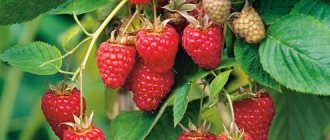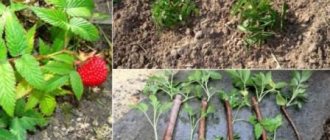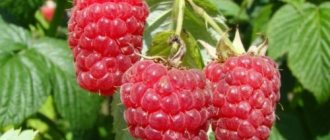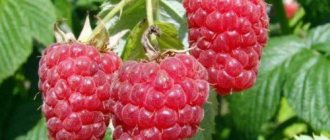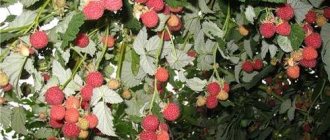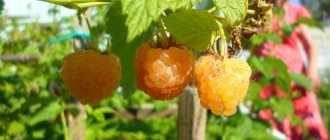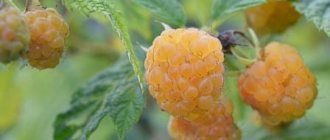Raspberry Heritage is a proven remontant variety that has not lost its popularity for half a century. High-yielding, unpretentious and proven over the years - the variety deserves to take up residence in your garden.
From the article you will learn about the pros and cons of the Heritage variety, methods of pest control, and also about the correct planting of bushes to obtain maximum yields.
raspberry variety "Heritage"
Heritage raspberry bushes bear fruit until frost
For half a century (since 1969), the variety has not lost its position and is still among the leaders in industrial cultivation
What does Heritage raspberry look like?
Raspberry Heritage is a subshrub about 2 m high. The shoots are erect and have small thorns.
The bush is slightly spreading, its shoot-like ability is average. Strong fruit branches are collected in inflorescences at the base of the shoot. The leaf blade is dark green, oblong.
The berries are cone-shaped with a blunt apex, are fine-grained and one-dimensional. Ripe berries have a pleasant raspberry hue and a rich, sweetish aroma. The average fruit size is 3-3.5 g. The taste is pleasant, sweet with a slight sourness.
Care
In order to grow this variety of raspberries and get a good harvest, you need to follow the rules associated with planting and care. It is necessary to take into account the timing and location of planting. The optimal period for planting a bush in a new place is September. In this case, the seedling will have time to take root well enough. The first harvest can be harvested next season in August. It is necessary to take into account a feature that will help maintain the health of the bush itself and the quality of the collected berries: the most suitable place for placing the bush is an area where there is loose fertile soil, it should be located on the south side.
Lighting
The lighting should be good, since if the bush is located in the shade, the yield is noticeably reduced and the size of the berries decreases. Raspberry Heritage does not like strong or long-term shade, so the place for planting it must be chosen carefully. There are also special requirements for the soil where the bush should grow.
Requirements for creating ideal soil
Planting must take into account the acidity of the soil. The soil must be loose so that oxygen and nutrients can easily flow to the root system. Soil-podzolic class soils are excellent for the Heritage variety.
Particular attention should be paid to the amount of moisture in the area - its excess harms the plant. Therefore, unsuitable areas for bushes are lowlands, depressions, places where water stagnates for a long time after rains or watering
If you need to plant seedlings in the spring, you need to prepare the soil in advance; this should be done before winter. Autumn planting will require site preparation 30 days before the procedure. Additionally, the soil for raspberry bushes can (and sometimes must) be supplemented with organic substances and mineral fertilizers.
Features - per 1 m² of area allocated for bush planting of raspberries you need to add:
- Potassium (sulfate is chosen for the purpose of fertilizer) - about 32 g (the amount varies and depends on the quality of the fertile soil);
- Organics – 10-12 kg (ready-made or composted).
You will also need to add some phosphorus substances (about 60 g). For rapid and confident growth of a newly planted plant, the soil must be neutral in acidity, or a slightly acidic option is allowed, which will be an ideal agricultural solution. Since raspberries of this variety do not like humidity, you need to ensure that the groundwater level does not rise above 1.5 meters in places where bushes are planted. If the soil is acidic, phosphorus supplements are mandatory.
Pruning: necessary or not?
The Heritage raspberry variety requires timely pruning in spring and autumn. Also, during the period of ripening and formation of fruits, you need to constantly water the bushes. Peculiarities of pruning: in October you need to cut off shoots that are already 2 years old at that moment, right to the root. In April (spring pruning), those shoots that froze during the winter period and became dry are removed. All branches damaged for various reasons are also removed.
Pruning should be done to keep the bushes healthy, vigorous and strong.
If the crop is harvested once per calendar year, then the main pruning is carried out in the middle of the autumn period. At this point, good gardeners remove all branches from the bush to the base. In the spring, only strong and strong shoots are left from the young shoots that have grown. Feature - their total number should be no more than 6 branches.
Advantages and disadvantages of the variety
A characteristic feature of this variety of raspberries is its remontant nature - the ability to bloom and produce several harvests during one growing season.
In addition, moderate shoot-likeness does not allow remontant raspberries to spread throughout the entire area, which is typical for most “classic” summer varieties.
Other benefits of Heritage raspberries include:
- high productivity;
- good frost resistance;
- one-dimensionality of berries;
- self-fertility;
- slight studliness;
- transportability and keeping quality;
- immunity to diseases;
- versatility of fruit purpose.
The remontant variety has many advantages, which is why it is popular not only among Russian gardeners and summer residents, but also among large industrial planters in Europe and America.
Heritage, like any variety, has its disadvantages:
- the quality of the crop depends on the application of organic and mineral fertilizers;
- the need to control the level of moisture in the root zone;
- obligatory garter of shoots;
- loss of sugar content in berries due to excessive watering.
Some raspberry experts also consider the average size of the berries to be a disadvantage, but the high taste qualities more than offset this disadvantage. With the right agricultural technology, raspberries will not become smaller and will delight you with a stable, high-quality harvest throughout the season.
An overview of the Heritage raspberry variety is presented in the video below:
Reviews
I've been growing Heritage for 4 years, I'm happy with the choice. Raspberries do not require special care and soil quality. The seedlings are growing well. Over the course of four years, I grew raspberries from five cuttings on three acres. Raspberries begin to sing from the end of July to the end of August or beginning of September (Donbass). Among the disadvantages: the taste is slightly inferior to the summer disposable varieties, it requires gartering on trellises.
Heritage in taste and aroma of berries will give a head start to many modern varieties. After long summer rains, the berries retained their sweetness. I also like the fact that they do not leak or wrinkle during transportation. There are a lot of ordinary summer berries in the garden, but I leave Heritage for autumn fruiting. Therefore, I trim all the shoots to zero in the fall. I advise you not to thicken the plantings, this makes the berries tastier, more fragrant and the harvest larger.
The ancient raspberry variety Heritage is distinguished by the fact that it gives a stable, good harvest when basic conditions are met, as for ordinary raspberries.
Preparing for landing
Heritage will fully demonstrate its positive characteristics only under the condition of competent agricultural technology. Growing remontant raspberries does not require any special skills; you just need to stock up on knowledge, and an abundance of juicy and tasty berries will not take long to arrive.
In order for Heritage raspberries to easily take root and develop properly, several important conditions must be met before planting:
- choose healthy seedlings;
- select an area for a raspberry garden;
- fertilize the soil;
- plant bushes on time.
Selection of seedlings and transportation
It is advisable to purchase raspberry seedlings from gardening nurseries or specialized online stores. It is not recommended to buy raspberries at spontaneous markets, since unregistered traders rarely monitor the varietal purity and quality of the plants they sell.
Choose medium-sized seedlings that have 2-3 well-formed shoots. There should be at least 3 living buds at the base, which will subsequently produce young fruit-bearing branches. When purchasing, pay attention to the appearance of the root system. A healthy plant has roots that are elastic, dense and moist.
Nurseries and stores offer seedlings with both open (OKS) and closed (ZKS) root systems. Plants with ACS are cheaper, but they need to be planted immediately. Seedlings in containers have better survival rate and can be planted from spring until the first frost.
You should not purchase seedlings whose roots are packed in a plastic bag. Such prolonged waterlogging leads to rotting of the root system and death of the plant.
After purchasing raspberries with OCS, wrap them in a damp cloth, and upon arrival, immediately dig them in the garden plot. Place seedlings with ZKS level and secure them firmly so that the container does not turn over during transportation.
Place for raspberries
Pay special attention to choosing the territory for the future raspberry garden, since the crop will grow in this place for 10-15 years. Remontant raspberries are light-loving, but planting bushes in too open areas is undesirable. In winter, shoots suffer from frosty winds and the buds may die.
In the scattered shade the shoots stretch out. The culture grows well in fertile, breathable soils with low groundwater levels. The optimal soil pH for growing raspberries is 5.7-6.5.
Soil preparation
It is advisable to prepare the soil for raspberries 1.5-2 months before planting the bushes. This is necessary to saturate the soil with nutrients, create an optimal water-air regime and destroy harmful organisms. You can get rid of weeds by either digging up the area or using herbicides.
To increase soil fertility by 1 sq. I need to enter:
- 10 kg of organic fertilizers;
- 45 g superphosphate;
- 200 g of ash.
After applying fertilizer, carefully dig up the area. You cannot plant raspberry seedlings in the place of an old raspberry tree if less than 4 years have passed since its removal.
Planting period
Heritage is planted both in spring and autumn. Experienced gardeners prefer autumn planting. Planted in the first half of October, the bushes will have time to take root before frost and will immediately begin to grow with the arrival of warmer weather.
By postponing planting work until spring, you risk not having time to plant the plants before the buds begin to open, which will negatively affect the survival rate of the bushes. Even with timely planting, heat may come before the raspberries have time to take root well.
You can get more information about planting raspberries in spring from this article.
Landing
Heritage raspberries require warm, cloudy weather to plant. Therefore, in the southern regions it is recommended to plant raspberries in the fall, and in the northern latitudes - in the spring.
You might be interested! Description of the second most popular variety of raspberry trees - standard raspberry Skazka.
When determining a place for growing remontant varieties, it is always important to remember that the berries of these raspberries ripen in late summer and autumn, so a well-lit place with sunshine is extremely necessary for raspberry growing. In the spring, in such a place the snow will melt faster and the earth will warm up, which means that young shoots will appear earlier, because they need to have time to grow and bear fruit over the summer. Raspberries do not like through winds, as well as nearby groundwater, even such a moisture-loving one as Heritage.
The soil is suitable fertile, loose, drained. If the soil on the site is depleted by previous plants, then you need to add manure, humus, forest soil, bird droppings, wood or straw ash. Take a closer look at the weeds in the area; if horsetail or horse sorrel grows, then the soil is acidic, you need to dig it up with slaked lime, you can scatter old cement or plaster. The site needs to be prepared several months before planting. If you plan to plant cuttings in the fall, then all work must be done in the spring.
After the soil has been fertilized, cleared of weeds, and dug up, you need to dig trenches or holes for seedlings 35-40 cm deep. They also need to be filled with garden soil mixed with fertilizers. Rotted manure or chicken droppings are suitable for organic matter, and wood ash can be added as mineral fertilizers. This nutrient mixture will help young bushes quickly grow and take root.
It is better to buy cuttings from trusted nurseries, because gardeners often complain about substitution of varieties when purchased at spontaneous markets. The root system of the cuttings is covered with garden soil, watered, and the root zone is mulched to retain moisture. The root collar should be at ground level.
Step-by-step instructions: how to plant Heritage raspberries correctly?
Before planting seedlings with OCS, immerse them in a bucket of water for a couple of hours. This will saturate the plant with moisture. Remove the raspberries from the pot and straighten the roots.
Heritage raspberry planting algorithm:
- Dig a planting hole 40x40 cm.
- Place the seedling so that the root collar protrudes 4 cm above the ground. Cover with soil.
- Compact the soil around the plant, forming a border. Trim shoots to 30 cm.
- Water the raspberries at the rate of 30 liters per bush and mulch the tree trunk circle with compost.
How to choose Heritage raspberry seedlings
They are sold by nurseries or special online stores. They should have 2 to 3 formed shoots. With 3 live buds at the base.
The root system should be elastic, dense, and moist. You can buy seedlings with an open root system cheaper than with a closed one. But they need to be planted immediately. If you purchase a seedling in a container, it will take root better and can be planted from spring to autumn.
It is better not to purchase shoots packaged in polyethylene. Because the roots may rot and the whole plant will die. OKS should be wrapped immediately in damp cotton wipes. Take care of the ZKS in containers so that they do not turn over on the way.
Subshrub care
Remontant raspberry is an unpretentious subshrub. If the garden is abandoned, it continues to grow for many years. But without proper care, the bush weakens, is affected by pests and diseases, and the berries become smaller. If you regularly devote time to raspberry growing, Heritage’s yield will reach 5 kg of berries per bush.
Caring for remontant raspberries includes:
- regular watering;
- bush pruning;
- tying to a support;
- feeding;
- mulching the tree trunk circle;
- activities to prepare for winter.
Watering mode
Raspberry Heritage does not tolerate drought well, so regular sufficient watering is an important condition for the proper development of the bushes.
The remontant variety especially urgently needs abundant watering from May to August. Lack of moisture during this period leads to the formation of weak shoots and a decrease in productivity by at least a third.
The best option is to organize drip irrigation. You will not have to constantly monitor the soil moisture; it will be normal. The irrigation system prevents water from getting on the leaves and berries, and the likelihood of developing bacterial and fungal diseases is reduced.
The first watering is carried out at the end of spring, when the buds begin to actively grow. Next, the raspberries are watered based on weather conditions and the rate of drying of the soil. To moisten the soil to a depth of 30-40 cm, add at least 2 buckets of water per 1 square meter. m beds.
Try not to over-moisten the soil to prevent the roots from rotting. On hot, dry days, irrigate the bushes every day, during the rainy season - once a week.
Pruning branches
Fruiting in Heritage raspberries occurs on both two-year-old and one-year-old shoots. In order to get 2 harvests the next season, pruning is carried out using a special technology.
In October-November, after picking the berries, the two-year-old shoots that bear fruit are completely cut out, leaving the one-year-olds. In April, only branches damaged during the winter are removed. In this case, you will get a summer harvest on old shoots, and an autumn harvest on young shoots.
However, experts in berry crops recommend growing Heritage for 1 harvest. At the end of October, after picking the berries, cut off all the branches on the subshrub, leaving no stumps. With this technology, you will get larger, sweeter berries, and the plants will get sick less often.
We recommend reading the article on how to properly prune raspberries in the fall.
Tying to a trellis
Heritage's shoots are quite tall and need support. Tying raspberries to a trellis makes it easier to care for the plant, harvest it, and also increases the productivity of the bushes.
Wooden posts with a height of at least 1.5 m are installed along the rows and galvanized wire is secured between them. It is advisable to stretch it in 2 rows at a height of 0.7 m and 1.5 m. Each branch is tied to the trellis separately.
Root feeding
Early spring fertilizing is needed to accelerate the growing season and the growth of young shoots. Nitrogen-containing fertilizers are best suited for this:
- infusion of bird droppings;
- mullein;
- ammonium sulfate;
- Azofoska.
Organic fertilizers are diluted with water in a ratio of 1:10. For 1 sq. m of raspberry plant, add 5 liters of infusion. Mineral fertilizers are added to the soil according to the instructions.
During flowering and fruiting, bushes require potassium supplements: potassium sulfate (25 g per 10 liters of water) or wood ash infusion. After the first berries appear, feed the Heritage bushes with nitrophoska, diluting 45 g of fertilizer per 10 liters of water.
Autumn fertilizing is not needed when growing raspberries for 1 harvest. Leaving annual shoots to winter in anticipation of a summer harvest next year, feed the bushes with fertilizers. Scatter 1 tsp under each bush. calcium sulfate and superphosphate, mulch the soil.
Mulching
Soil mulching is an agricultural technique aimed at reducing moisture evaporation in the root zone and improving the water-air regime.
Raspberry roots lie at a depth of 30 cm from the surface of the earth, so they easily dry out in the heat and freeze in winter. Using mulch, you will protect the root system of the bushes from these problems.
The best mulch for Heritage raspberries is:
- peat;
- sawdust;
- compost;
- straw;
- rotten foliage.
Black spunbond is also used to mulch plantings. Its advantage over organics is that it protects raspberries from weeds. Mulch remontant raspberries in the fall - before the first frost, and in the spring.
Shelter for the winter
Before frosts, the soil around the bush should be loosened, and moisture-recharging watering should be carried out at the rate of 50 liters of water per 1 square meter. m.
If you are growing Heritage for 2 harvests, remove the annual shoots from the trellis, bend them to the ground and tie them in bunches. For regions with little snow and cold winters, you will need to cover the shoots with agrofibre or other garden material.
Raspberries grown for 1 harvest are sprinkled with humus or sawdust after pruning. The covering layer should be at least 10-15 cm.
Landing Features
The yield of the Heritage variety depends not only on the composition of the soil, but also on the place of cultivation, so before planting raspberries, you should correctly select and prepare the site in advance. Only in this case will the plant take root well, develop correctly and produce a stable harvest of tasty berries.
Selection of seedlings
It is recommended to buy raspberry seedlings from specialized retail outlets or garden nurseries. Zoned planting material takes root best.
The quality of the seedling is determined by the following criteria:
- The escape. Its thickness should be no more than 1 cm. The seedling consists of 1–2 well-developed shoots.
- Root. The length is at least 15 cm, it must have many small roots.
Annual and biennial plants are suitable for planting in open ground.
The length of the seedling is not particularly important, since when planting it must be trimmed to a length of 25–30 cm
Dates and place of landing
Heritage raspberries are planted in spring or autumn, but planting in September is preferable. The seedling has time to take root well and the first harvest can be obtained as early as August next year.
The most comfortable place for shrubs will be an area with loose fertile soil on the south side. The area should be well lit. With full or partial shading, the yield decreases and the berries become smaller.
Raspberries do not tolerate excess moisture well, so it is not recommended to plant them in areas with stagnant water and in lowlands. The groundwater level should be no higher than 1.5 m.
Soil acidity also affects plant development. Raspberries are suitable for slightly acidic or neutral soil.
Site preparation
For spring planting, the soil is prepared in the fall. When planting in the autumn season, preparations are carried out a month before the procedure. To enrich the soil with mineral and organic substances, 12 kg of humus, 60 g of phosphorus fertilizers, and 35 g of potassium sulfate are added per 1 m² of land. After this, they dig up the soil, simultaneously removing all the weeds.
Step by step process
To ensure that the soil adheres tightly to the roots, when filling the hole, the seedling is slightly shaken and at the same time the soil around it is trampled down
Before planting, raspberry seedlings are immersed in water for 1–2 hours. Then the root of the plant must be dipped into a clay mash.
- Dig a planting hole 40 cm wide and 35 cm deep.
- Lower the seedling into the hole. The root collar should be 3–4 cm above the soil level.
- Straighten the root and cover it with soil, gently trampling it with your foot.
- A hole with a soil edge is made around the seedling.
- The shoots are trimmed, leaving 25–30 cm from the ground.
- Water the plant with 25–35 liters of water.
- The hole is mulched with sawdust, peat or dry soil.
When planting several bushes, a distance of 60–70 cm between seedlings and 1.5–2 m between rows should be maintained. There should be no more than two raspberry bushes per square meter.
How to plant remontant raspberries - video
Raspberry Heritage propagation
Anyone can grow remontant raspberries; this does not require special skills or knowledge.
Heritage is propagated in 3 ways:
- offspring;
- root cuttings;
- green cuttings.
Green cuttings are cut 3-5 cm below ground level in spring or autumn and rooted in a greenhouse.
Root shoots are dug up and planted in the fall, when their above-ground part is 5-10 cm.
Root cuttings are carried out after harvesting. To do this, dig up the root of a healthy bush and cut it into shoots 10-15 cm long.
Care and maintenance
Normal development and growth of a seedling is impossible without proper care for the “new resident”.
As mentioned earlier, the yield and taste of berries depend on timely watering, so raspberry gardens must be irrigated twice a week, even in the case of light rains (the latter rarely moisten the soil more than 10 cm in depth).
Pre-winter watering is carried out at the end of November, thus improving the frost-resistant qualities of the subshrub and laying down prospects for the development of growth buds.
Depending on the growing method, raspberry trees are also pruned. In the case of remontant varieties that produce 2 harvests, pruning of shoots is carried out in autumn and spring . In the fall, two-year-old shoots are cut out, and in the spring, weak and diseased shoots are cut out.
Tying up
Raspberry garter solves the problem of holding drooping tops and bending stems, and also makes it easier to pick the berries.
The Heritage variety requires staking. Most often, a garter is made in 2 ways:
- simple;
- fan-shaped
In the first case, a wooden stake is installed in the middle of the bush, to which tall shoots are tied. In the second, special supports are installed between the bushes, between which half of the branches from each bush are fixed.
Priming
Raspberries respond well to preliminary soil cultivation and preparation of a nutritious planting mixture.
The Heritage variety is very picky regarding soil quality.
This is one of its few drawbacks, so the soil for raspberries must be fertilized periodically. To do this, in March, fertilizers containing nitrogen, phosphorus and potassium are applied to the soil. During the flowering period, superphosphate and potassium sulfate are added to the soil, and after harvesting, humus or compost is added.
The Heritage variety has good frost resistance, and yet some gardeners cover it for the winter with special gardening material, having first poured peat or humus under each bush. Experts do not recommend using straw or rotten leaves, as small rodents can settle in them and harm the plant.
Disease prevention and pest control
With proper agricultural practices, Heritage raspberries rarely get sick and are subject to pest attacks.
To protect yourself as much as possible from possible problems, follow simple preventive measures:
- remove weak, unhealthy growth;
- adhere to the feeding regime;
- When cutting out shoots, do not leave stumps;
- regularly carry out preventive treatments with fungicides and insecticides;
- Do not allow water to get on the leaves and berries when watering.
The Heritage raspberry variety can be attacked by the following pests:
- Raspberry beetle . You can protect your plantings from the raspberry beetle by treating the bushes with Confidor or Decis before flowering.
- Shoot and leaf aphids . You can get rid of small colonies by treating raspberry leaves with laundry soap foam.
- Stem gall midge . The affected branches are cut and burned, the bush is treated with Karbofos.
- Raspberry gallworm . All affected branches must be cut out and burned. Before the buds open, raspberries are treated with Decis for prevention.
Signs of Unhealthy Raspberry Bushes
Developing healthy Heritage raspberry bushes have elastic, powerful shoots without cracks, uniform dark green leaf color and regular berry shape.
Below are the signs that signal the onset of a bush disease:
- uneven color of the leaf plate;
- wrinkling or curling of leaves;
- yellowing of the bush;
- drying of shoots;
- the appearance of any spots on the bush;
- rotting or drying of berries.
If you notice warning signs, take action immediately. Bacterial and fungal diseases spread quickly, so in a short period of time all bushes can become sick.
Common diseases of this raspberry variety:
- rust;
- white spotting;
- anthracnose;
- chlorosis;
- goiter of roots.
Diseases and pests
Insect pests of Heritage raspberries, control and prevention measures - table
| Pest | Description and nature of the lesion | Processing period | Control measures | Prevention |
| Raspberry beetle | The insect is gray-brown in color, up to 6 mm long. Females gnaw holes in the buds and lay eggs in them. The larvae gnaw out the contents of the buds and the tissue on the leaves between the veins. It manifests itself as extensive damage to the leaves of the bush. You can also find larvae in the berries when picking. | Before flowering | The drug Confidor according to the instructions. |
|
| Before the buds open | Digging the ground under the bushes to a depth of 15–20 cm. | |||
| Raspberry leaf and shoot aphids | Small insects of light green color. They live in small groups on the underside of leaves, feeding on their sap. The leaves turn yellow and dry out. The shoots stop growing and the number of ovaries decreases. | Before the buds open | Preparations Karbofos, Actellik, Nitrafen according to instructions. | |
| Raspberry stem gall midge | Mosquito up to 2.3 mm long. The larvae are orange. The larva develops under the bark, feeding on the sap of the plant. Signs of damage: swellings up to 3 cm in diameter appear on the stems. Cracks form in the bark. The shoot weakens and dries out. | Before flowering | Preparations Ambush, Karbofos according to instructions. | |
| Raspberry moth | Small insects about 3 mm long. The larvae lay on the bark near the buds. Nature of the lesion: the larvae feed on plant sap. Signs of damage: swellings up to 10 mm in diameter appear on the shoots. The branches become brittle and dry out. | During the growing season | Cutting out and burning affected shoots. |
Harmful insects in the photo
The raspberry beetle is one of the most dangerous raspberry pests.
Raspberry aphids cause curling of leaves, curvature and underdevelopment of shoots, shortening of internodes, weakening of young growth and fruiting
Raspberry stem gall midge damages young raspberry shoots in the larval stage, causing them to dry out
Raspberry borer damages raspberry stems
Diseases of the Heritage raspberry variety, control and prevention measures - table
| Types of diseases | Description and nature of the lesion | Processing period | Control measures | Prevention |
| Rust | Fungal disease. Affects leaves and shoots. Nature of the lesion and manifestation: in May, yellow-orange small tubercles appear on the upper part of the leaf, petioles, and young shoots. Later, brown pustules appear on the lower part of the leaf, which turn into a dark coating by autumn. The stems break and dry out. | Before the leaves bloom | DNOC 1%, Nitrafen 3% - treat the bush and soil between the rows. |
|
| Before flowering | Bordeaux mixture 1%. | |||
| Anthracnose | A fungal disease that develops on wild plants in regions with a constantly humid climate. Its spores can be carried by birds, insects or wind. It is manifested by the presence of gray spots with a purple border on the leaves, along the edges and along the veins, on the shoots. The leaves curl and fall off. | At the beginning of bud break | Urea solution 5%. |
|
| Before the flowers bloom | Bordeaux mixture 1%. | |||
| After flowering | Copper oxychloride. | |||
| Purple spot | Fungal disease. Its spores overwinter on fallen leaves. Purple-brown spots appear in the places where the leaves are attached. With further development of the disease, the spots ring the entire shoot. Necrotic spots form on the leaves, and the leaf blade dries out. The bark of the branches becomes gray, peels and cracks. | Early spring | Nitrafen 2%. | Dusting the soil under the bush with wood ash. |
| At the beginning of bud break | Bordeaux mixture 1%. | |||
| After picking berries | The drug Oleocuprit according to the instructions. | |||
| Chlorosis | Viral disease. In mid-summer the leaves turn yellow. In the initial stage, yellowing is observed along the veins. Young shoots become thin and elongated. The berries dry out without ripening. | July August. | Affected bushes are completely uprooted and burned. | In early spring, the bush is sprayed with Bordeaux mixture 1% or copper oxychloride. |
| Root cancer (goiter) | The disease is caused by a bacterium. The pathogen penetrates the root system mainly through wounds caused by soil cultivation or by insects. Dark brown growths appear on the roots and bases of shoots, and growth decreases. The infection is introduced with water, soil and planting material. | Autumn, spring. | Uprooting a bush. |
|
Raspberry diseases in the photo
With chlorosis, dark spots appear on the leaves
Rust is more harmful in areas with high humidity
Purple spot usually affects weakened, insect-damaged bushes.
With root canker, yield, frost resistance and drought resistance are sharply reduced
Anthracnose leads to a decrease in the size and quality of fruits that grow on affected shoots
Collection and storage of berries
Heritage berries ripen at the end of August. Fruiting is extended and can last until early October. The timing depends on weather conditions and the growing region.
On average, 3 kg of berries are harvested from one bush, and with intensive feeding - up to 5 kg. The harvest takes place once a week.
At temperatures up to +4 degrees, the berries do not lose their properties and appearance for up to 2 weeks. For longer storage, fruits are frozen in the freezer.
The Heritage variety has good transportability.
Analogues of the Heritage variety
Heritage analogues include:
Brusvyana with an average weight of 12 to 15 g. Begins to bear fruit in mid-August. 8 kg are collected from a bush.
Atlas with a weight of 6 to 8 g. Fruiting from September. From one plant you get from 2 to 2.5 kg.
Polana weighs from 3 to 5 g and produces ripe fruits in July - August. From one plant - from 3 to 4 kg.
Zyugana weighs from 8 to 10 g. Ripens in September. From a bush - from 7 to 12 kg of berries.
Raspberry Heritage, with its excellent taste and ease of care, although in some respects it lags behind its competitors, is in demand among farmers and gardeners.
Which raspberry varieties are similar to Heritage?
Most often, Heritage is compared with such remontant varieties as Zyugana, Polana, Atlant and Brusvyana (see Table 1).
Table 1 - Comparative characteristics of remontant raspberry varieties
| Variety name | Average fruit weight, g | Beginning of fruiting | Average yield per bush, kg |
| Heritage | 3-3,5 | end of August | 3-5 |
| Zyugan | 8-10 | September | 7-12 |
| Polana | 3-5 | July August | 3-4 |
| Atlant | 6-8 | September | 2-2,5 |
| Brusvyana | 12-15 | mid-August | 8 |
The table shows that Heritage is inferior to some varieties in terms of yield and berry size. However, the excellent taste of the fruit and the unpretentiousness of the crop make this variety popular both among summer residents and industrial planters.
Description of the variety
Raspberry Heritage is a remontant variety; it has successfully taken root and is cultivated in amateur and industrial gardening in Ukraine, Belarus, in the middle zone and southern Russia.
The bush is not very spreading, 1.8-2 m high, its branches are strong, upright, moderately covered with dark thorns. A distinctive feature of the shoots is that by the end of summer they become almost red. The fruiting zone occupies the upper third of their total length; the berries are collected in compact clusters on strong, thick fruit branches. The bush produces a small amount of root shoots, but it is enough for reproduction already 2-3 years after planting.
You might be interested! Description of the representative of the “golden varieties” - the Gusar variety. Productivity up to 16 kg. from the bush and that's not the limit!
The leaves are medium sized, oblong, dark green, corrugated.
The berries have the shape of a short cone, one-dimensional, medium size, weighing 3-3.5 grams; when fully ripe, they become dark burgundy in color, without falling off, they can hang on a branch for up to five days.
The pulp is tender, juicy, distinguished by an excellent sweet and sour taste and intense raspberry aroma. The purpose of berries is universal. On a five-point tasting scale, the taste of Heritage raspberries is rated at 4.6 points.
On the shoots of the second year, the first berries begin to ripen in mid-July, the picking period lasts two weeks. This harvest is not distinguished by quality and abundance. The second harvest begins in mid-September, but the bulk of the berries do not always have time to ripen before frost.
Young shoots produce one harvest, which begins to ripen at the end of August and ripens already with stable frosts. Most gardeners recommend growing these raspberries only with annual shoots to obtain a better harvest.
The average yield of the variety is 3-3.5 kg per bush, but in a good year, with proper care, you can harvest up to 6 kg.
Advantages of the variety
- stable fruiting;
- high taste characteristics of fruits;
- high transportability of the crop;
- the ability of berries to hang on the branches for a long time after ripening without losing their taste and shape;
- bush endurance in severe frosts;
- slight growth of shoots;
- high immunity to diseases and resistance to pests.
Disadvantages of the variety
- not high drought resistance;
- the need to equip trellises for gartering bushes;
- with a lack or excess of moisture in the soil, as well as in autumn, the berries become more sour.
How do gardeners respond to Heritage raspberries?
Reviews from summer residents and gardeners about Heritage raspberries are mostly positive:
★★★★★
Alexander, 62 years old, gardener, Voronezh. Excellent taste of berries, customers like it.
I grow about 17 Heritage bushes, the yield is excellent! ★★★★★
Maria Stepanovna, 56 years old, summer resident, Moscow. I grow Heritage for 1 harvest.
The berry is large, sweet, and stores well. Next season I want to try to get 2 harvests, I hope the quality of the berries will not suffer from this. ★★★★★
Ekaterina, 40 years old, amateur gardener, Krasnodar. I like Heritage for its taste and abundance of harvest.
This season I want to increase the number of bushes and remove Polka. Heritage also has more berries, and it bears fruit much longer. Hide
Add your review
0
0
Copy link
Strengths
- Interesting, smile-making characteristics of raspberries are posted on American websites. Specifically, “deer-resistant, bird-repellent, and bee-friendly.” Apparently, in some states, deer are serious pests of raspberries. It would be nice to add the term “bear-resistant” to increase the sonority and solidity when characterizing our domestic varieties.
- Stable yield indicators.
- Good self-pollination, thanks to which the variety can be successfully grown both in open and closed ground conditions.
- Good adaptation to various growing conditions, relative unpretentiousness in agricultural technology. This raspberry is suitable for both amateur gardening and industrial cultivation.
- Heritage produces an average amount of root shoots and replacement shoots, and does not spread far from the place of growth. This all saves energy and time.
- The variety has a long cultivation history, proven by generations of farmers and ordinary gardeners.
- The berries are sweet, raspberry-tasty, juicy, with a pronounced aroma, with a berry aftertaste.
- The fruits are universal in use. Suitable for both sale and all types of processing.
- Good keeping quality and transportability of berries. They are suitable for long distance transport, especially when refrigerated and maintaining a stable temperature. Typically this indicator is +2°C.
- Raspberries have high frost resistance and good resistance to many diseases and pests.
- In cool, rainy weather, the berries retain their taste and quality.
- Possibility to grow the variety as a tutaymer, capable of producing 2 harvests. But I would like to make a reservation right away - our hero falls very far short of real timers, like Maravilla.
Characteristics of the variety
Gardeners often leave positive reviews about the Heritage remontant raspberry. To understand all the advantages of the variety, it is worth familiarizing yourself with its characteristics in more detail.
Drought resistance, frost resistance
If you look at the map of temperature zones, then in terms of frost resistance the Heritage variety can be grown in areas designated 4 to 8. Regions with a long warm period and moderate winters are more suitable for raspberries. According to reviews, Heritage raspberries can survive frosts down to –30°C if the plant is well covered. In fact, the root system can withstand a maximum temperature drop of up to –20°C. If the winter in the region is not severe, do not cover the remontant raspberry bushes for the winter.
Attention! High humidity, snowless winters, and pests that have taken root on the branches weaken the raspberries. The bush can freeze even in mild frosts. The drought resistance of the remontant variety is average
Raspberries love the sun, but also do not refuse watering. Excess moisture will affect the yield and quality of berries
The drought resistance of the remontant variety is average. Raspberries love the sun, but also do not refuse watering. Excess moisture will affect the yield and quality of berries.
Heritage raspberry yield
The remontant variety Heritage bears fruit until mid-October. Cold areas are already experiencing frosts at this time of year. The ripening of berries begins in mid-August. If the raspberries are not given special care, up to 3 kg of harvest can be harvested from the bush. The remontant variety is capable of bearing fruit twice per season. If raspberries are given this opportunity and given a lot of attention, the yield will increase to 5 kg per bush.
Area of application of fruits
Raspberries are a berry for jam, healing, tasty, vitamin-rich. If desired, the harvest can be used for compote, jelly, decoration of baked goods and other sweet dishes. If carefully assembled, the berries can be stored in the refrigerator for up to 1.5 weeks. The crop tolerates transportation over short distances. If desired, Heritage raspberries can be frozen.
Resistance to diseases and pests
A special feature of the Heritage raspberry variety is its high resistance to diseases. Breeders tried to achieve resistance of the remontant variety to pests, but harmful insects are not averse to feasting on the juicy foliage and berries. Most often, aphids are found on raspberries, accumulating on the back side of the plate. If you do not carry out preventive spraying of the bushes, the number of ovaries will decrease.
Advantages and disadvantages of the variety
Remontant varieties are more capricious compared to ordinary raspberries; they have their own positive and negative features in their characteristics. The advantages of Heritage include the following qualities:
- stable fruiting and high yield;
- average frost resistance allows you to grow remontant raspberries without shelter in many areas;
- fragrant delicious berries;
- the crop can be transported without reducing the quality of the presentation;
- the remontant variety is resistant to diseases and most pests.
If we talk about the disadvantages of the Heritage variety, then they also exist. Remontant raspberries require mandatory fertilizing with organic matter and mineral complexes. Excess moisture increases the wateriness of the berries and reduces their sweetness. The downside of this variety is that it is difficult to care for. The branches of remontant raspberries must be tied up at the beginning of fruiting, otherwise they will break off under the weight of the berries.
Pros and cons of this raspberry variety
Raspberry Heritage is loved for several of its properties:
- This berry variety is distinguished by high and, best of all, stable yield.
- The berries have a very pleasant taste.
- Raspberry fruits are easy to transport.
- This berry is adapted to Russian conditions - it is not afraid of the cold.
- Raspberries have few shoots, which means they will not take over the entire garden plot.
- Raspberries are rarely affected by various diseases.
But, as often happens, there are some downsides:
- If the plant grows in the southern regions, it will need additional watering.
- Raspberries are unlikely to grow healthy without fertilization.
- If there is a large amount of rain or excessive watering, there will be more berries, but they will lose the richness of taste.
- Although the yield of this raspberry variety is high, the size of the berries is small compared to the berries of other, newer varieties.
